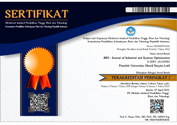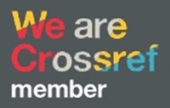ANALISIS HUMAN ERROR PADA PROSES PEMINTALAN BENANG DI RING SPINNING FRAME MENGGUNAKAN METODE HUMAN ERROR ASSESMENT AND REDUCTION TECHNIQUE (HEART) DAN ROOT CAUSE ANALYSIS (RCA) ( Studi Kasus : PT. Delta Dunia Sandang Tekstil )
DOI:
https://doi.org/10.51804/jiso.v5i1.47-53Keywords:
Human error, HEART, RCA, 5 why methodsAbstract
PT Delta Dunia Sandang Tekstil merupakan perusahaan yang bergerak di bidang industri tekstil, yang berfokus pada proses pemintalan benang. Penelitian ini berfokus pada proses produksi ring spinning frame. Proses produksi ring spinning frame tidak terlepas dari adanya produk cacat, jenis cacat yang terjadi seperti benang tidak rata, benang tipis, benang tebal dan benang gembos. Berdasarkan hasil observasi kesalahan dapat terjadi pada manusia ataupun pada mesin. Berdasarkan hasil perhitungan menggunakan metode HEART menunjukkan bahwa probabilitas kesalahan manusia dengan nilai HEP sebesar 0,135. Selanjutnya diterapkan metode RCA dengan bantuan tools 5 why methods untuk mencari akar penyebab masalah untuk meminimalisir terjadinya human error. Berdasarkan hasil RCA diperoleh faktor penyebab human error adalah Para operator kurang memiliki pengatahuan dan pengalaman yang cukup dalam melakukan proses penyambungan benang, operator belum terbiasa menyambung benang dari depan dan kurang memahami posisi badan dalam menyambung benang dengan benar, operator kurang fokus dan tidak teliti saat menyambung benang karena banyaknya benang yang putus, belum adanya sop perusahaan dalam hal menyambung benang secara detail, kurang training secara berkala yang dilakukan oleh perusahaan, belum terdapat prosedur disetiap line produksi untuk mengurangi kesalahan pada proses kerja, Tidak ada peringatan kesalahan menyambung benang. Berdasarkan hasil dari pengolahan data menggunakan metode HEART dan RCA didapatkan usulan perbaikan dalam proses produksi ring spinning frame yaitu perusahaan perlu memberikan training secara berkala kepada karyawan tentang bagaimana bekerja secara tepat untuk meminimalisir human eror, perusahaan perlu memberikan prosedur disetiap line produksi untuk mengurangi kesalahan pada proses kerja, perusahaan perlu membuat peringatan kepada karyawan sehingga karyawan tidak melewati batas prosedur yang ditentukan perusahaan, perusahaan perlu memberikan alat peredam kebisingan.
ABSTRACT
PT Delta Dunia Sandang Tekstil is a company engaged in the textile industry, which focuses on the yarn spinning process. This research focuses on the production process of ring spinning frames. The production process of ring spinning frames is inseparable from the existence of defective products, types of defects that occur such as uneven yarn, thin yarn, thick yarn and loose yarn. Based on the results of observations, errors can occur in humans or in machines. Based on the results of calculations using the HEART method, it shows that the probability of human error with the HEP value is 0.135. Furthermore, the RCA method is applied with the help of the 5 why methods tools to find the root cause of the problem to minimize the occurrence of human error. Based on the results of the RCA, the factors causing human error were the operators lacked sufficient knowledge and experience in the process of connecting threads, operators were not used to connecting threads from the front and did not understand the body position in connecting threads correctly, operators were less focused and not careful when connecting. thread due to the large number of broken threads, the absence of a company soup plan in terms of connecting threads in detail, lack of regular training carried out by the company, there is no procedure in each production line to reduce errors in the work process, There is no warning of thread connecting errors. Based on the results of data processing using the HEART and RCA methods, it is found that the proposed improvement in the ring spinning frame production process is that the company needs to provide regular training to employees on how to work properly to minimize human errors, the company needs to provide procedures in each production line to reduce errors in the process. At work, companies need to make warnings to employees so that employees do not cross the limits of the procedures specified by the company, companies need to provide noise suppression devicesReferences
Alatas, A. H., & Putri, R. J. K. (2017). Identifikasi Human Eror Pada Proses Produksi Cassava Chips Dengan Menggunakan Metode Sherpa Dan Heart Di PT. Indofood Fritolay Makmur. Jurnal PASTI, XI(1), 98–110.
Bell, J., & Holroyd, J. (2009). Review of human reliability assessment methods. In Health & Safety Laboratory.
Dewi, H., Maryam, M., & Sutiyarno, D. (2018). Analisa Produk Cacat Menggunakan Metode Peta Kendali P Dan Root Cause Analysis. Jurnal Teknologi Pertanian, 7(2), 10–18.
Pratama, R. A. (2017). Analisis Human Error Pada Operator Mesin Cetak Dengan Metode Hierarchical Task Analysis (HTA) Dan Fuzzy Heart. Jurnal Rekayasa Dan Manajemen Sistem Industri, 5(7).
Mas’idah, E., Syakhroni, A., & Rachmawati, A. A. (2019). Analisis Kesalahan Manusia Pada Pengemudi Bus Rapid Transit (BRT) Menggunakan Metode Human Error Assessment And Reduction Technique (HEART) dan Systematic Human Error Reduction And Prediction (Studi Kasus?: Brt Koridor I, Trans Semarang). Opsi, 12(2), 77.
Masita, M., & Indah Pratiwi, S. T. (2017). Analisis Human Error dengan Metode SHERPA dan HEART Pada Proses Produksi Batik Cap (Studi Kasus di UKM Batik Cap Supriyarso, Kampoeng Batik Laweyan Surakarta). Universitas Muhammadiyah Surakarta.
Rachmawati, A. A. (2019). Human Error Assessment And Reduction Technique (HEART) dan Systematic Human Error Reduction And Prediction (Studi Kasus?: Brt Koridor I, Trans Semarang). Universitas Islam Sultan Agung.
Downloads
Published
Issue
Section
License
With the receipt of the article by JISO Editorial Board and the decision to be published, the copyright regarding the article will be transferred to JISO. The copyright transfer form can be downloaded here.
JISO has the right to multiply and distribute the article and every author is not allowed to publish the same article that was published in this journal.
JISO is licensed under a Creative Commons Attribution-ShareAlike 4.0 International License.
Under the following terms:
Attribution — You must give appropriate credit, provide a link to the license, and indicate if changes were made. You may do so in any reasonable manner, but not in any way that suggests the licensor endorses you or your use.
ShareAlike — If you remix, transform, or build upon the material, you must distribute your contributions under the same license as the original.














